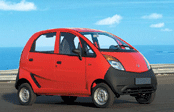Indian Carmaker Unveils World's Cheapest Car

The tiny Nano sedan costs only $2,500
by Beth Rowen
 The Tata Nano Standard Version Related Links
Nano Specs
|
The newest Nano has four wheels and runs on two cylinders. No, Apple Computer did not introduce a self-propelled MP3 player (not yet, anyway). The Tata Nano is a tiny, five-door hatchback that was unveiled at a car show in early January 2008 in New Delhi, India.
A two-cylinder engine, which is located in the back, powers the car. The Nano, nicknamed the "People's Car," can reach speeds of up to 65 miles per hour and gets about 50 miles per gallon of gasoline, which is on par with most hybrids. The five-seat mini car, which looks a lot like a bubble on wheels, is about 11 feet long and 5 feet wide.
Cheap but Spare
At only $2,500, the Nano lacks many of the accessories and luxuries of other, more expensive cars. Indeed, it doesn't have a radio, air conditioning, power steering, or power windows, and the dashboard is adorned with only a speedometer, an oil light, and a fuel gauge.
Ratan Tata, the chairman of the Tata Group, which developed the Nano, said he hopes to sell about one million of the cars in India.
"We indeed have a People's Car, which is affordable and yet built to meet safety requirements and emission norms, to be fuel efficient and low on emissions," Tata said. He chose the name "Nano" because the word "connotes high-tech and small size," he said.
Environmental Impact
While some auto enthusiasts hailed the Nano for its fuel efficiency and low price, which will provide mobility to a much wider population in India, many environmentalists are concerned that a million new cars in India, the world's second-most-populous country, with a population of more than 1.1 billion, will contribute further to global warming. Indeed, India's emissions of carbon dioxide are the fourth highest in the world, and New Delhi, the capital of India, is the fourth-most-polluted city in the world. Some suggested that Tata should have used his significant resources to work toward improving India's mass transportation system rather than further clog India's already intolerably congested roads.
"In my view, this represents a bankruptcy of policy as far as transport options are concerned," said chief U.N. climate scientist Rajendra Pachauri, who shared the 2007 Nobel Peace Prize with Al Gore. "If our roads are going to be flooded with these cars by a few million each year, what is that going to do? Every car that goes on the road is going to use road space. Congestion and air pollution are twin problems," he said. "Why not improve the quality and reliability of buses?"







